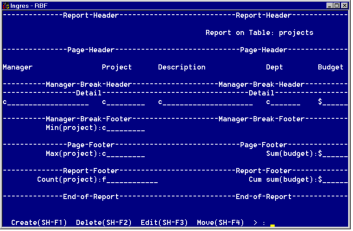Report Structure
A RBF report can contain some or all of the following sections:
Report header
Printed on the first page of the report.
Page header
Printed at the top of the second and subsequent pages of the report.
To print the Page Header on the first page of the report as part of the report header, use the ReportOptions operation. For instructions, see the chapter “Working with RBF Report Specifications.”
Break header
Printed before the report's detail lines. A report can have one break header for each column designated as a sort column. On the report specification, the break header contains the name of the associated sort column. For example, in the following figure, the column associated with the break header is the Dept column, so the break header is titled Dept‑Break‑Header.
If a report has multiple break headers, they are printed in the order designated by the sort sequence of the sort columns. For example, the first break header contains the column with a sort sequence of 1, the second break header contains the column with a sort sequence of 2, and so forth.
To define the sort sequence, use the ColumnOptions operation. For instructions, see the chapter “Working with RBF Report Specifications.”
Detail lines
Printed for each row in the table, view, or JoinDef associated with this report.
Break footer
Printed after the report's detail lines. A report can have one break footer for each column designated as a sort column.
On the report specification, the break footer contains the name of the associated sort column. For example, in the following figure, the column associated with the break footer is the Dept column, so the break footer is titled Dept‑Break‑Footer. As with break headers, if a report has multiple break footers, they are printed in the order designated by the sort sequence of the sort columns.
Page footer
Printed at the bottom of each report page.
Report footer
Printed at the end of the report.
The following figure shows a report specification with all of the report sections listed. The break, page, and report footers contain aggregates. The aggregates are discussed in the chapter “Working with RBF Report Specifications.”

Default Report Layout
The report sections that appear in your report are determined initially by the default report layout for the report style you chose.
The default layout for each report style is shown in the following table. For instructions, see the chapter “Working with RBF Report Specifications.” The Layout operation, also described in that chapter, allows you to add and delete some report sections to customize the report.
Report Styles | Report Header | Page Header | Break Header | Detail | Break Footer | Page Footer | Report Footer |
|---|---|---|---|---|---|---|---|
Tabular | yes | yes | yes | yes | no | yes | no |
Wrap | yes | yes | no | yes | no | yes | no |
Block | yes | yes | no | yes | no | yes | no |
Indented | yes | yes | yes | yes | no | yes | no |
Master/Detail | yes | yes | yes | yes | no | yes | no |
Labels | yes | yes | no | yes | no | yes | yes |
Last modified date: 07/21/2025